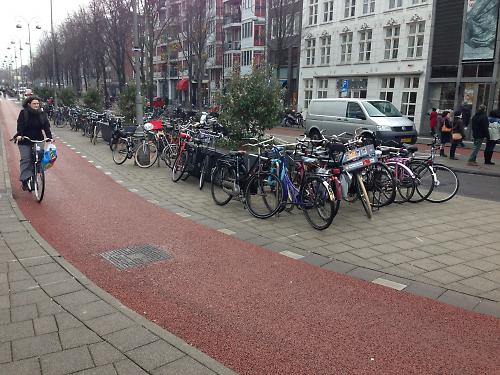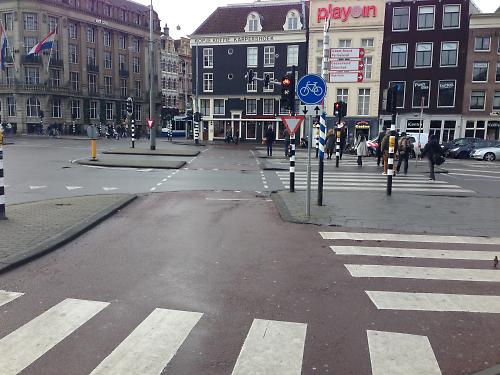- News
- Reviews
- Bikes
- Accessories
- Accessories - misc
- Computer mounts
- Bags
- Bar ends
- Bike bags & cases
- Bottle cages
- Bottles
- Cameras
- Car racks
- Child seats
- Computers
- Glasses
- GPS units
- Helmets
- Lights - front
- Lights - rear
- Lights - sets
- Locks
- Mirrors
- Mudguards
- Racks
- Pumps & CO2 inflators
- Puncture kits
- Reflectives
- Smart watches
- Stands and racks
- Trailers
- Clothing
- Components
- Bar tape & grips
- Bottom brackets
- Brake & gear cables
- Brake & STI levers
- Brake pads & spares
- Brakes
- Cassettes & freewheels
- Chains
- Chainsets & chainrings
- Derailleurs - front
- Derailleurs - rear
- Forks
- Gear levers & shifters
- Groupsets
- Handlebars & extensions
- Headsets
- Hubs
- Inner tubes
- Pedals
- Quick releases & skewers
- Saddles
- Seatposts
- Stems
- Wheels
- Tyres
- Health, fitness and nutrition
- Tools and workshop
- Miscellaneous
- Tubeless valves
- Buyers Guides
- Features
- Forum
- Recommends
- Podcast
OPINION
Opinion: Do cycle? Go Dutch!

Cycling in Britain is going through a huge number of changes at the moment; in 2012 a Brit won the Tour de France for the first time since - ever - and Team GB has enjoyed unparalleled success in recent Olympics led by such human ‘machines’ as Sir Chris Hoy, Sir Bradley Wiggins and Victoria Pendleton.
Currently Britain really does rule the wheels; any sport in which we beat the French at their own game usually goes down well in the national psyche.
Bikes, bikes everywhere - it must be Amsterdam
It’s all terribly impressive and coupled with rising fuel costs, train fares, insurance, congestion and concerns for the environment it’s no surprise that the general public wish to take to the streets on two wheels as well.
However that’s when the problems start as Britain’s roads for the past 60 years have been designed with motoring in mind. The 1950s optimism of the open road and the freedom personal car ownership provided haave been lost in 2013’s polluted, congested and overweight British cities.
The government wants people to cycle, people want to cycle, but the recent spate of cycling fatalities in London has revealed a terrible lag in legislation, road design and cultural attitudes to cycling. This has led to calls for us to emulate the world’s most cycle-friendly nation - the Netherlands - of which Amsterdam is the cycling capital of the world, and ‘go Dutch’.
Reports, studies and white papers are so full of the term it’s bordering on the obsessive. From Dutch-style segregated lanes to Dutch-style roundabouts and ‘Mini Hollands’ it won’t be long till we swap white for orange shirts in time for the Football World Cup next year. The possibility of having to ‘go Dutch’ explodes my head with euphemisms.
Amsterdam loves bikes
So what’s it like cycling in Amsterdam? Well having just come back from visiting there last weekend, it’s pretty great. Integrating cycling into street layout has been a fundamental part of planning in Amsterdam for decades. Streets incorporate wide largely segregated cycle lanes (Fietspad) with separate traffic signals, low rise kerbs and slow moving low numbers of motorised vehicles.
The streetscape is remarkably open - free of safety railing ‘rat runs’, bollards, unnecessary and confusing signage and it seems to work all the better for it. The result is outstanding, the air is clean and quiet, the roads are peaceful, and streets are just attractive and pleasant places to be.
However adapting infrastructure is the easy bit, changing the public’s behaviours and attitudes to ‘going Dutch’ will take longer.
In Amsterdam people of all ages and backgrounds cruise around in upright single speed bikes. No-one wears a helmet or protective pads, no-one wears ghastly high vis jackets, no-one wears lycra and few people have cycle lights. You can even borrow bikes from your hotel when you visit it’s that ingrained.
The amount of fuss you get for not having one or all of these things while cycling in Britain, you would expect the streets of Amsterdam to be like the first day on the Somme but they’re not; bike related fatalities hover around 6 people per year.
The cultural attitude of cycling in London is that you have to look like something akin to a medieval knight or Imperial Storm Trooper (along with a large dose of ‘Dutch courage’). It’s a classic example of treating the symptom, not the condition.
It would be wrong to say that Amsterdam doesn’t have transport problems of its own (in many ways it’s a victim of its own success), yet it is consistently regarded as one of the most ‘liveable’ cities in the world.
The Government may be moving along the right lines with gearing up investment in cycle infrastructure, but culture behaviour change will take much longer than watching the blue paint dry on another Cycle Superhighway.
It's time to cross over to a better way of building cities - for everyone
More Opinion
Latest Comments
- chrisonabike 1 min 31 sec ago
They're too prone to puncture. You end up having to use Schwalbe Extra Safe (which aren't easy to get on)....
- chrisonabike 6 min 49 sec ago
The other issue is it might well cost a substantial chunk of that 20 pounds for all the admin (especially chasing late or non-payment, enforcement...
- chrisonabike 11 min 31 sec ago
Seconded - not a Londoner and never lived there so have no idea. But ... I used to visit and ... it's quite big. In fact, more like a series of...
- TomDW 2 hours 30 min ago
Any experienced London cyclist will tell you don't leave a £1K bike locked up especially in Shoreditch. This could all have been avoided. Having an...
- belugabob 2 hours 30 min ago
Where did the e-bike doc go wrong? It got past the proposal stage...
- David9694 2 hours 45 min ago
Person trapped after campervan flips in Devon crash...
- Hirsute 3 hours 35 min ago
My wife forgot to tell me about this and now the 48 hour deadline has passed. No ved either.
- mark1a 4 hours 45 min ago
Thanks to all at road.cc HQ, I received my t-shirt, socks and stickers in the post this morning. Stickers are already being stuck:
- Simon E 6 hours 33 min ago
The total cost of putting a complete bike on a UK showroom floor is considerably more complex than the Bank of England's inflation figures. Some...
- hawkinspeter 7 hours 20 min ago
There's plenty of traffic along Avonvale and Marsh Rd already without needing to encourage it.







Add new comment
13 comments
Yes to what Henny says above. Here in Berlin I take my hybrid when doing errands, and wear street clothes, bring the children, use the bike paths, etc… when going out for sport it's a road-bike and I stay off the bike path for the most part whilst heading out of town. And the road bike is never left unattended on the street!
Crucial here is that most car owners also ride bikes so there isn't a two-tribes mentality as there seems to be in the UK.
Regularly I am in Amsterdam and in London, please realize that Amsterdam is a little town compared to London, therefore much easier to organize. We, Dutch, also tend to bike in two different ways, going to work / shopping etc we take our old single speed, slow, heavy duty bike but if we go for sport we take our sport bike (if you park your sport bike in the centre of Amsterdam it will be stolen within 5 minutes). Somehow in London all the people on bikes look like if they are ready for a sportive of 100 km. Anyway, lots of luck and wisdom in order to have London become a cycle safe city!
I thought the reflectors on pedals thing could be dealt with by simply having reflective surfaces on your shoes or by wearing reflective bands/trouserclips. My shimano shoes have this built in and my neoprene overshoes have scotchlite trimming, you can also obtain "black" reflective tape which can be a stealthy way to get that reflective effect without ruining the look of your gear.
http://www.beacongraphics.com/brightbike.html
Maybe this belongs in the Daily Mail as I think we're all 100% 'converted' here.
As to PCSOs and the lack of reflectors on clipless pedals, I think that would be a very petty enforcement of the letter of the law. Many riders who use clipless pedals also have several lights and reflectives. Save the wrath of the law for the morons whose bikes have no lights at all and enforce the spirit of the law, not the letter.
Like others I have been told by County Council Planners that crap infrastructure has been approved by Sustrans.
In one case when I investigated it turned out to be untrue.
However, Sustrans have approved and built a lot of very low standard infrastructure. They need to revise and radically improve their design standards and implementation.
I thought their area manager's comments about cyclists with drop handlebars being the scourge of shared use paths were silly, for sure. Then again, he's got far more local cycle routes built than you, or me, or any funny old men with mirrors on their helmets.
I've built a few, well they weren't cycle routes as such, more dirt jumps and downhill trails, and you know what? There weren't any problems with folk riding with drop bars, but walkers would wander into the course oblivious, despite signs and verbal warnings, joggers would try to run up the downhill track with hilarious results and folk would leave logs, rocks, tacks and other crap in the trails, in the end the whole area had to be fenced off which killed the whole vibe. The vast majority of pedestrian folk enjoyed stopping to watch and offered words of support and encouragement, most also enjoyed the fact that as part of the deal we kept the immediate vicinity well maintained and segregated bike paths from footpaths. Unfortunately a minority of dickheads had to ruin it for everyone, this is the same problem that Sustrans routes have and some of those dickheads ride bikes with drop bars.
And a 'Dutch Rudder' has nothing to do with handlebar stems either.
You do realise that Dutch Courage is a euphemism for boozing right?
I do want to have a little cry to myself when I see some of the infrastructure Sustrans signs off, with crap surfacing, barriers, speed bumps, and give way markings at side roads (even where said cycle route is basically a pavement!). They know that these things aren't up to Dutch standards, but they have to work with local authority partners and highway engineers or nothing gets done at all.
What they have done, which none of their detractors have managed to do, is to make a really big section of the general public aware of how pleasant it is to cycle on traffic-free routes. And their marketing and campaigning tries to push cycling back into the arena of something that's done by "normal" people. They're not perfect but for my money they're achieving far more than any other campaign group at the moment.
O, if only they were traffic-free! The high numbers of ill-mannered users on routes like the Bristol and Bath Railway Path has led to well-publicised conflict and it's been the road bikers who Sustrans have chosen to criticise, every time that I've seen.
And in at least two cases I know, better provision would probably have been made, except that Sustrans readily agreed to substandard rubbish when local campaigners were holding out for something without obvious crash hazards: then the locals get told "but we checked with Sustrans and they say this is OK." In one case, when the crash hazards were pointed out to Sustrans, I understand that they said they hadn't spotted them and told local residents to raise it with the council safety audit team - who dismissed the concern because the design had been approved by Sustrans!
Some days I wonder if nothing getting done may have been better than Sustrans, actually.
Don't worry about it a.jumper, nothing will be happening on the infrastructure front... instead hobby bobbies are going to be given the power to fine you for not having reflectors on your clipless pedals:
http://www.bikebiz.com/news/read/pcsos-soon-able-to-fine-cyclists-withou...
"Clause 135 of the Anti-social Behaviour, Crime and Policing Bill will give police community support officers (PCSOs) in England and Wales new powers to stop and fine cyclists who do not have lights on their bikes. But not just lights. PCSOs will also be able to stop and fine cyclists if they don't have reflectors on their bicycles, including on the pedals. Clipless pedals don't have reflectors fitted to them, but to be street legal all bicycles will need to have a rear reflector and two reflectors on each pedal."
Does this mean sustrans is going to stop accepting second class compromises?